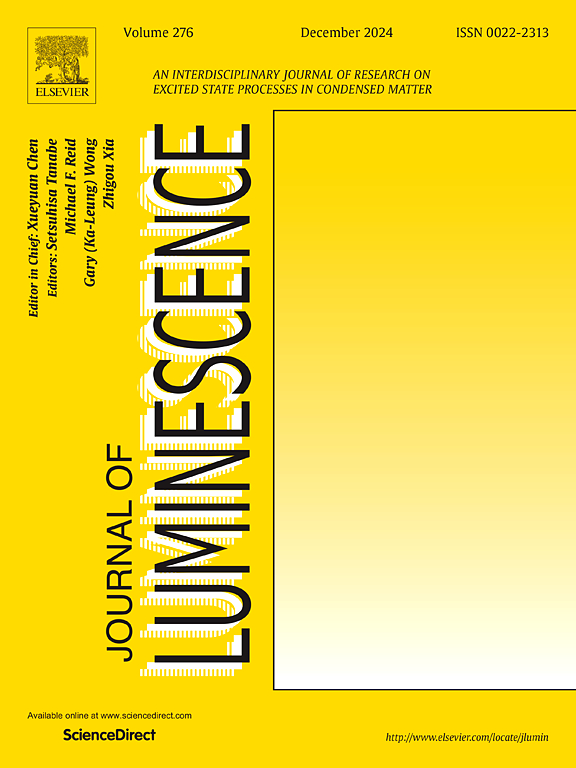Comparative studies of Er3+/Yb3+ co-doped GdCa4O(BO3)3, Gd0.5Y0.5Ca4O(BO3)3 and YCa4O(BO3)3 crystals as 1.55 μm laser materials
IF 3.3
3区 物理与天体物理
Q2 OPTICS
引用次数: 0
Abstract
Er3+ (1 at%) and Yb3+ (20 at%) co-doped GdCa4O(BO3)3, Gd0.5Y0.5Ca4O(BO3)3, and YCa4O(BO3)3 crystals were successfully grown by the Czochralski method. Their thermal, spectral, and 1.55 μm laser properties were investigated and compared. The thermal expansion anisotropy of the Er3+/Yb3+:Gd0.5Y0.5Ca4O(BO3)3 crystal is the weakest among the three crystals. The Er3+/Yb3+:Gd0.5Y0.5Ca4O(BO3)3 crystal has the larger absorption cross section at 976 nm and emission cross section at 1545 nm than those of the other two crystals. Caused by the high maximum phonon energy close to 1260 cm−1, the Yb3+→Er3+ energy transfer efficiency in all crystals is higher than 90 %. Under the identical experimental conditions, 1548 nm continuous-wave laser performance obtained in the Er3+/Yb3+:Gd0.5Y0.5Ca4O(BO3)3 crystal is superior to those of the other two crystals. The results show that the Er3+/Yb3+:Gd0.5Y0.5Ca4O(BO3)3 crystal may be a better 1.55 μm laser gain medium compared with the Er3+/Yb3+ co-doped GdCa4O(BO3)3 and YCa4O(BO3)3 crystals.
Er3+/Yb3+共掺GdCa4O(BO3)3、Gd0.5Y0.5Ca4O(BO3)3和YCa4O(BO3)3晶体作为1.55 μm激光材料的比较研究
用Czochralski法成功生长了Er3+ (1 at%)和Yb3+ (20 at%)共掺杂GdCa4O(BO3)3、Gd0.5Y0.5Ca4O(BO3)3和YCa4O(BO3)3晶体。研究并比较了它们的热性能、光谱性能和1.55 μm激光性能。Er3+/Yb3+:Gd0.5Y0.5Ca4O(BO3)3晶体的热膨胀各向异性是三种晶体中最弱的。Er3+/Yb3+:Gd0.5Y0.5Ca4O(BO3)3晶体在976 nm处的吸收截面和1545 nm处的发射截面比其他两种晶体大。由于最大声子能量接近1260 cm−1,所有晶体中Yb3+→Er3+的能量传递效率均高于90%。在相同的实验条件下,Er3+/Yb3+: gd0.5 y0.5 ca40o (BO3)3晶体的1548 nm连续激光性能优于其他两种晶体。结果表明,Er3+/Yb3+:Gd0.5Y0.5Ca4O(BO3)3晶体比Er3+/Yb3+共掺GdCa4O(BO3)3和YCa4O(BO3)3晶体具有更好的1.55 μm激光增益介质。
本文章由计算机程序翻译,如有差异,请以英文原文为准。
求助全文
约1分钟内获得全文
求助全文
来源期刊

Journal of Luminescence
物理-光学
CiteScore
6.70
自引率
13.90%
发文量
850
审稿时长
3.8 months
期刊介绍:
The purpose of the Journal of Luminescence is to provide a means of communication between scientists in different disciplines who share a common interest in the electronic excited states of molecular, ionic and covalent systems, whether crystalline, amorphous, or liquid.
We invite original papers and reviews on such subjects as: exciton and polariton dynamics, dynamics of localized excited states, energy and charge transport in ordered and disordered systems, radiative and non-radiative recombination, relaxation processes, vibronic interactions in electronic excited states, photochemistry in condensed systems, excited state resonance, double resonance, spin dynamics, selective excitation spectroscopy, hole burning, coherent processes in excited states, (e.g. coherent optical transients, photon echoes, transient gratings), multiphoton processes, optical bistability, photochromism, and new techniques for the study of excited states. This list is not intended to be exhaustive. Papers in the traditional areas of optical spectroscopy (absorption, MCD, luminescence, Raman scattering) are welcome. Papers on applications (phosphors, scintillators, electro- and cathodo-luminescence, radiography, bioimaging, solar energy, energy conversion, etc.) are also welcome if they present results of scientific, rather than only technological interest. However, papers containing purely theoretical results, not related to phenomena in the excited states, as well as papers using luminescence spectroscopy to perform routine analytical chemistry or biochemistry procedures, are outside the scope of the journal. Some exceptions will be possible at the discretion of the editors.
 求助内容:
求助内容: 应助结果提醒方式:
应助结果提醒方式:


